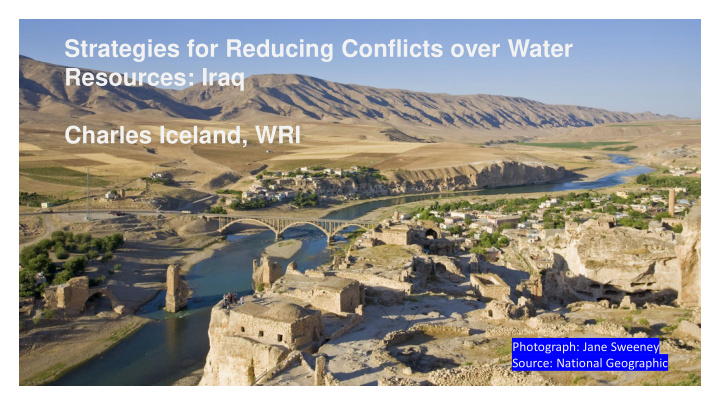



Strategies for Reducing Conflicts over Water Resources: Iraq Charles Iceland, WRI Photograph: Jane Sweeney Source: National Geographic
Basra, Iraq, September 2018: Iraqi protesters break into an official building as they demonstrate against the government and the lack of basic services in Basra on September 6, 2018. Haidar Mohammed Ali/AFP/Getty Images. – Vox September 8, 2018.
Shatt al-Arab Diminishing river flows in the Tigris, Euphrates, and Karun rivers have permitted saltwater from the Gulf to advance up the Shatt al-Arab waterway (below the confluence of the Tigris and Euphrates rivers), ruining productive farmland and drinking water sources in southern Iraq (Abdullah et al. 2016, Al-Wazzan 2018, Bloomberg 2018). Photo: LooxLex
Photo caption: Sewage is dumped into one of the rivers extending to Shatt al-Arab in Basra, Iraq . Photo: Reuters. Source: 2019 www.behindthelogos.org
SOLUTIONS RISK DRIVERS New centralized sources of water (wastewater Diminished rainfall treatment and reuse for industry, irrigation) More severe droughts Increasing temperatures Transboundary water-sharing agreements Lack of effective transboundary water-sharing agreements Water use limitation/demand caps Increasing water demand Population policies that lower fertility rates Increasing population Demand too high relative to supply New centralized sources of water (wastewater Lack of wastewater treatment treatment and reuse for industry, irrigation) Water efficiency and conservation improvements Inefficient water use in agriculture Food security policies; open global food market access Urban/rural development policies Leak-detection technologies and reduced water Massive losses in urban water systems losses Reduced corruption Corruption Improved governance Poor governance Data collection and information systems Lack of accountability Gender equality Gender inequality
Winter precipitation trends in the Mediterranean region for the period 1902 - 2010. Credit: NOAA (from Hoerling et al., 2011).
Reds and oranges highlight lands around the Mediterranean that experienced significantly drier winters during 1971-2010 than the comparison period of 1902-2010. Credit: NOAA (from Hoerling et al., 2011).
DROUGHT IN IRAQ, 2007 – 2009 Source: NASA
Source: Wiltgen , N. 2015. “Feels -Like Temp Reaches 164 Degrees in Iran, 159 in Iraq; Days Off Ordered as Mideast Broils in Extreme Heat Wave.” Weather.com. August 5, 2015.
MacQuarrie (2004) estimates the combined annual flow of the two rivers at 84.2 billion cubic meters, of which 65.7 bcm comes from Turkey (78.1%), 11.2 bcm from Iran (13.3%), 6.8 bcm from Iraq (8.1%) and 0.5 bcm from Syria (0.5%).
Gleick 2014. Annual average discharge of the Euphrates River measured at Jarabulus just downstream of the Turkey – Syria border from 1937 to 2010 (data from UN-ESCWA 2013).
The surface area of the Mosul Dam reservoir has shrunken by 63% over the past two decades (Iceland, Luo, and Donchyts 2018).
CRIPPLING LEVELS OF WATER POLLUTION Only 14 of 252 cities in Iraq had wastewater treatment plants as of 2006. These plants serve 8% of the population. About 70% to 83% of sewage water is directly discharged to rivers. Source: Al-Ansari, N., S. Aljawad, N. Adamo, V. Sissakian, J. Laue, and S. Knutsson . (2018). “Water Quality within the Tigris and Euphrates Catchments.”
IRRIGATION (IN)EFFICIENCY IN IRAQ Water losses in irrigation schemes, all over Iraq, are substantial . By and large, water is conveyed to farmers’ fields through very poorly maintained distribution systems made of earth canals and ditches which suffer significant water losses because of infiltration, seepage or leakage. On-farm field application efficiency using the traditional surface gravity systems is assumed to be between 30 – 40 percent but is probably near 20 percent or less . Source: ARDI-Irrigation water assessment and priorities for Iraq, 2004. Cited in FAO. 2012. “Iraq – Agriculture sector note.” FAO Investment Centre.
MASSIVE LOSSES IN URBAN WATER SYSTEMS In 2006, only about 32% of Iraq’s treated water actually reached customers (i.e., water system losses of 68%). Source: Alwash, A., H. Istepanian, R. Tollast, and Z.Y. Al- Shibaany . 2018. “Towards Sustainable Water Resources Management in Iraq.” Iraq Energy Institute. Publication Number: IEI 300818. 30 August 2018.
GENDER INEQUALITY Like other countries throughout the world, Iraq faces specific challenges to gender equality entrenched in its legal and political systems that are interlinked with religious and cultural norms. As a result, “women are … unable to contribute fully economically, socially and politically.” With women not able to fully engage in water resources decision- making, this leads to sub-optimal outcomes. It also precludes fertility- lowering strategies from working. Sources: Vilardo and Bittar 2018, Morna 2000, Mommen, Humphries-Waa and Gwavuya 2017, Kholif and Elfarouk 2014, UNDP and Gender and Water Alliance 2006, Lecoutere, D'Exelle and Van Campenhout 2015, UNFPA 2018.
SOLUTIONS RISK DRIVERS New centralized sources of water (wastewater Diminished rainfall treatment and reuse for industry, irrigation) More severe droughts Increasing temperatures Transboundary water-sharing agreements Lack of effective transboundary water-sharing agreements Water use limitation/demand caps Increasing water demand Population policies that lower fertility rates Increasing population Demand too high relative to supply New centralized sources of water (wastewater Lack of wastewater treatment treatment and reuse for industry, irrigation) Water efficiency and conservation improvements Inefficient water use in agriculture Food security policies; open global food market access Urban/rural development policies Leak-detection technologies and reduced water Massive losses in urban water systems losses Reduced corruption Corruption Improved governance Poor governance Data collection and information systems Lack of accountability Gender equality Gender inequality
Thank you! Questions? Charles Iceland Director Global and National Water Initiatives World Resources Institute ciceland@wri.org +1 202 729 7746 PHOTO: BOB NICHOLS | USDA
Recommend
More recommend